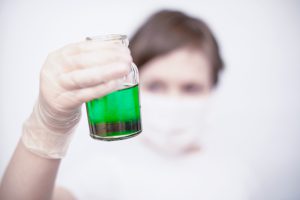Potential Risks Associated With The Use of Ozone and Ultraviolet (UV) Light Products for Cleaning CPAP Machines and Accessories: FDA Safety Communication
Date Issued: February 27, 2020
 The U.S. Food and Drug Administration (FDA) wants to make consumers and health care providers aware that, to date, the FDA has not authorized for market any products using ozone gas or ultraviolet (UV) light to clean, disinfect, or sanitize continuous positive airway pressure (CPAP) devices and accessories (for example: hoses, masks, tubing and headgear).
The U.S. Food and Drug Administration (FDA) wants to make consumers and health care providers aware that, to date, the FDA has not authorized for market any products using ozone gas or ultraviolet (UV) light to clean, disinfect, or sanitize continuous positive airway pressure (CPAP) devices and accessories (for example: hoses, masks, tubing and headgear).
CPAP machines are devices prescribed to patients with obstructive sleep apnea to keep their airways open during sleep. Most often, CPAP manufacturers recommend regular cleaning of CPAP device accessories with mild soap and water.
Important Recommendations for Consumers, Family Members and Caregivers:
- Follow the CPAP manufacturer’s instructions and recommended cleaning and replacement guidelines for your CPAP machine and accessories. If you cannot find the owner’s manual or instructions, or have questions, contact the CPAP device or accessory manufacturer. You also can contact your health care provider with any questions.
- Be aware that the FDA has not evaluated the safety and effectiveness of ozone gas or UV light products claiming to clean, sanitize or disinfect CPAP machines and accessories in the home or healthcare setting.
- Understanding the potential risks from exposure to excessive amounts of ozone gas or UV light include irritation to breathing passages (that is nose, throat, and lungs), particularly for those who have respiratory sensitivity such as asthma or allergies.
- Seek medical attention if you suspect you have experienced injuries or irritation from using products claiming to clean your CPAP machine or accessories.
Potential Risks Associated with Using Ozone Gas or Ultraviolet (UV) Light Products that claim to Clean, Sanitize, or Disinfect CPAP Machines and Accessories:
Using Ozone Gas Products that claim to Clean CPAP Machine Equipment and Accessories
Ozone (O3), sometimes called “activated oxygen”, is a gas that can be used to kill harmful bacteria. However, for ozone to be effective in destroying harmful bacteria, it must be present at a concentration above levels considered safe for humans.
Although products that claim to use ozone gas to clean CPAP machine equipment are designed to keep the ozone generated inside the machine and its accessories, leaks can occur at tubing connections, filters or through fabric containers used to house CPAP accessories. When leaks occur, ozone gas in the nearby space may temporarily rise to unsafe levels, especially if the space is not well ventilated. Ozone gas concentrations within the CPAP machine and tubing can also remain above safe levels even after the recommended waiting periods for ozone gas products that claim to clean. If the CPAP accessories are used without first allowing fresh air to circulate through the entire CPAP machine to remove any remaining ozone gas, this could lead to nasal, lung or any other type of irritation to the user’s breathing passages. Exposure to high levels of ozone gas also may worsen chronic respiratory diseases, such as asthma, or increase vulnerability to respiratory infection.
The FDA has received reports from patients experiencing cough, difficulty breathing, nasal irritation, headaches, asthma attacks and other breathing complaints when ozone gas-based products were used to clean, sanitize or disinfect CPAP devices and accessories.
Using UV Light Products that claim to Clean CPAP Machine Equipment and Accessories
UV light may be used to disinfect surfaces in a setting where UV light does not escape to the surroundings. If products generating UV light do not shield the user from exposure, they pose a potential health hazard depending on the wavelength, intensity, and exposure time.
Although FDA has not received any problem reports associated with using UV light products that claim to clean CPAP devices and accessories, unintentional or excessive exposure to UV light during cleaning may put a user at risk of eye injury, skin burns or even an increased risk of skin cancer. Additionally, when UV light is used with the purpose of disinfecting CPAP machine equipment and accessories, UV light may be unable to penetrate all areas of the CPAP accessories such as the hoses, masks and connectors. This may result in inadequately disinfected CPAP devices and accessories that may not be safe for reuse.
FDA Functions & Activities:
The FDA is working with manufacturers of products that claim to clean, sanitize or disinfect CPAP machines and accessories with either ozone gas or UV light to submit the recommended testing to support use of these devices as claimed.
Recently, the FDA conducted preliminary laboratory research on a few products claiming to use either ozone gas or UV light to clean, sanitize, or disinfect CPAP machines and accessories:
- For ozone gas products that claim to clean CPAP machines and accessories, tests performed in a minimally ventilated space with a volume representative of a small enclosed bathroom showed that several marketed ozone gas products generated ambient ozone levels above stated regulatory limits. Ozone levels were also elevated inside CPAP tubing even after recommended wait times in ozone gas products that do not perform an automatic clean air purge towards the end of the cleaning cycle.
- For UV light products that claim to clean, sanitize, or disinfect CPAP machines and accessories, tests showed the power of the UV light and the amount of time CPAP accessories were exposed to this light varied considerably among marketed UV cleaning products, based on the design of the product. If CPAP machines and accessories are exposed to insufficiently strong UV light, this could lead to inadequate disinfection and subsequent safety and performance issues.
The FDA will continue to monitor adverse events associated with the use of ozone gas or UV light products with claims to clean, sanitize, or disinfect CPAP machines and accessories.
Questions? Request more information from our specialist. Contact us ⇢⇢





